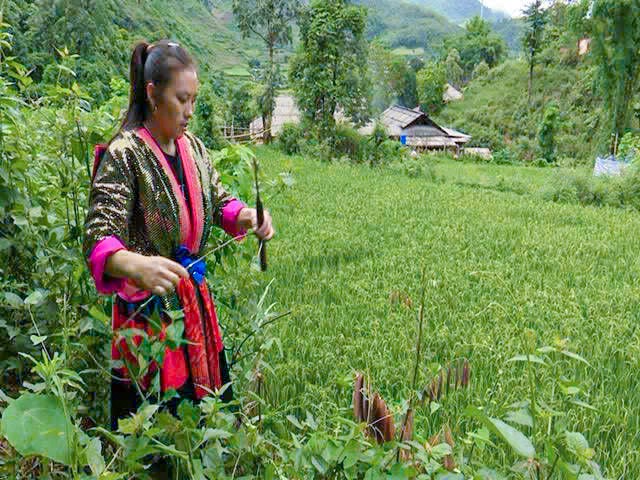While other regions often rely on young bamboo to create paper, the Mông people of Tủa Chùa use a different raw material – the bark of dây nhớt plant. This local bark is valued not only for its abundance but for the ease with which it can be harvested and processed. Though dây nhớt plant only appears for one season each year, locals make the most of its availability, collecting and drying the plant in large quantities to store as raw material for the months ahead.
The process of turning the dây nhớt bark into paper is as meticulous as it is traditional.
After gathering dây nhớt plant from the forest, the bark is peeled off and boiled with ash. This crucial step softens the bark, with the amount of ash determining the final colour and texture of the paper.
Once softened, the bark is soaked in cold water and thoroughly washed before it’s pounded or ground into a thick paste. The paste is then diluted with water, forming the pulp that will later be used to create the paper itself.
The next stage requires both skill and patience. The paper-maker carefully pours the pulp into a mould that stretches about two metres long. With a steady hand, they spread the mixture evenly across the surface, ensuring the right thickness and texture.
Once complete, the mould is set out in the sun to dry, and after several hours, the final product emerges - a sheet of durable, spongy, off-white paper, characterised by the slight roughness and distinctive fibres of handcrafted paper.
In the Mông community, it is the women who traditionally take on the responsibility of making this paper.
Their creations play a significant role in everyday life, used for writing, home decoration, and especially in the spiritual ceremonies that are central to Mông culture.
Whether cut into symbolic shapes or used in ritual offerings, the paper is deeply intertwined with the religious practices of the people, with each sheet a testament to the craftsmanship and devotion of its maker.
Despite the ever-growing march of modernisation, the art of paper-making remains a vibrant part of life in Tủa Chùa District.
Visitors to local highland markets will still find these sheets of handcrafted paper on display, a symbol of cultural resilience and the enduring connection between past and present.
Passed down from one generation of Mông women to the next, this cherished craft continues to embody the care, artistry, and reverence at the heart of the Mông people’s spiritual traditions.

The main material for making paper is the bark of the dây nhớt plant.
.jpg)
Handcrafted paper is cut into specific shapes for decoration and religious ceremonies during important festivals of the Mông people.
.jpg)
The paper mixture is diluted, spread onto a mould, and left to dry.

A paper with a distinctive off-white colour and the rough texture of the bark’s fibres.
.jpg)
Handcrafted paper is an essential item for the daily life of the local people.





.jpg)


.jpg)
.jpg)
.jpg)
.jpg)
.jpg)
.jpg)
.jpg)




.jpg)
.jpg)
You have 500/500 characters left
Please enter 5 or more characters!!!